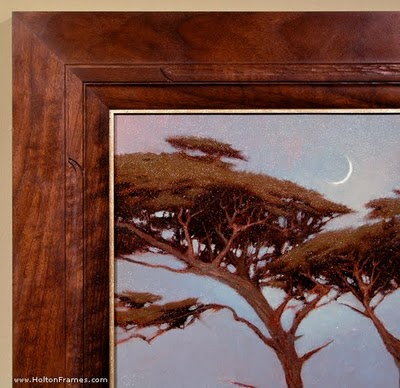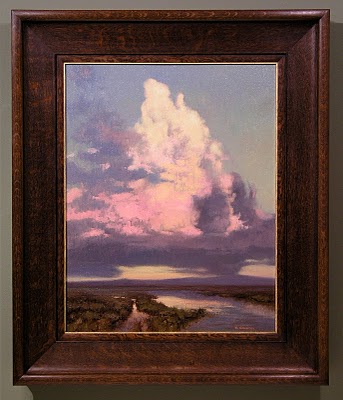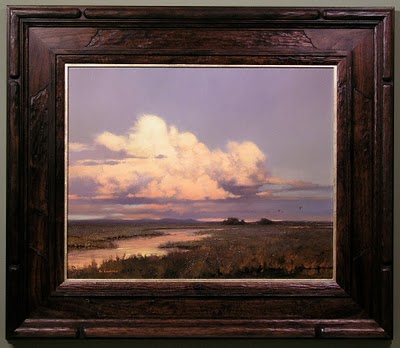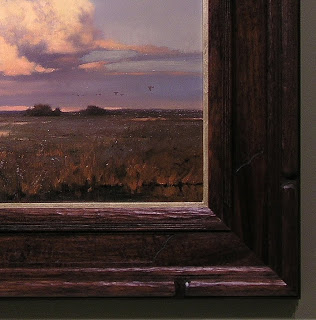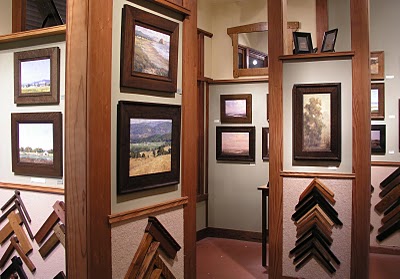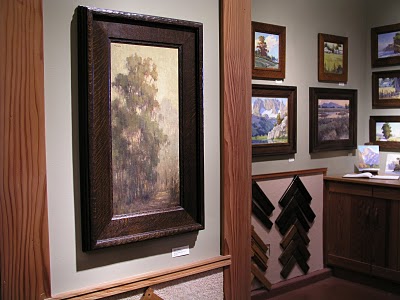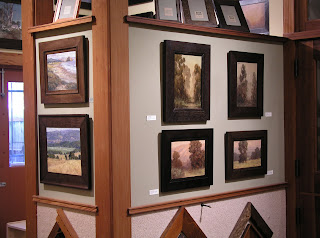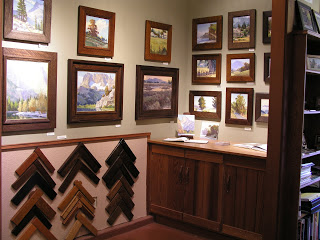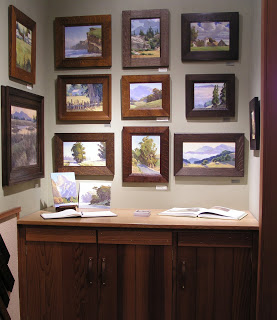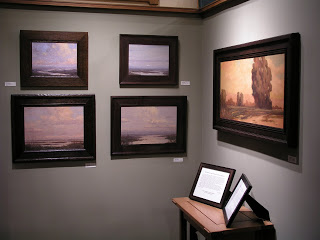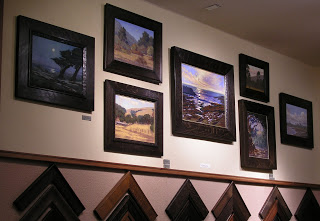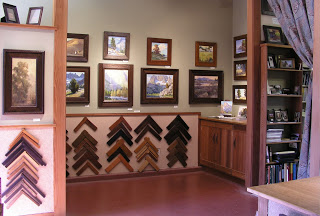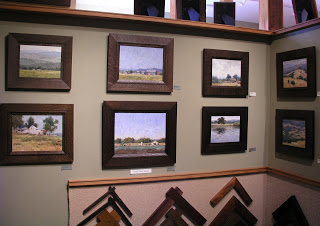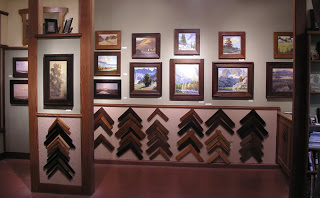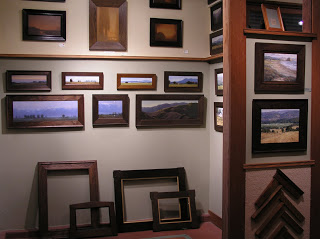Enjoyed framing this 12″ x 14″ oil for Kevin Courter, now at New Masters Gallery in Carmel. Chose walnut for its color (used a light stain to get the harmony just right) and because it’s good for carving. Chose a flat profile, since it’s a flat composition, but at the sight edge it’s got a very subtle convex, or ovolo, form echoing the form of the treetops cradling the moon. The frame similarly cradles the painting. The carved pattern takes its cue from the crescent moon and the branches. The narrow slip with lemon gold leaf matches the moon.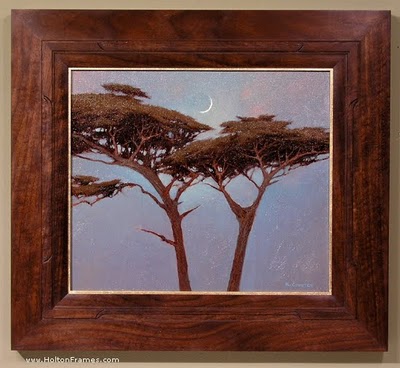
Archives
Framing Kevin Courter’s “Soaring Skies”
Just finished framing this wonderful Kevin Courter oil on linen, 20″ x 16″, titled “Soaring Skies.” I wanted the frame to extend the perspective with the right form and amount of line work, but keeping it simple and rustic in spirit. The color came out of the shadows in the grasses. Shadows are frequently a good source for frame color, helping the frame remain subordinate to the painting. The bright sunlight off the clouds suggested the gilt slip.
The painting is headed to New Masters Gallery in Carmel.
Framing Paintings—I: Kevin Courter’s “Colusa Sunset”
“All true art is praise,” as John Ruskin said, getting right at the heart of picture-making (and blowing the top off a lot of pretentious blather about art, too). Last fall Kevin Courter brought in this work of praise, a 16″ x 20″ oil on linen, less than 2 weeks before our show, “A Heaven in the Eye” was to open. It’s a stunner, as you can see, and to a frame-maker an inspiration. My enthusiasm and the extra focus imposed by the deadline spurred me to produce one of my favorite recent pieces.
Kevin says this is near Gray Lodge Wildlife Area off I-5 in Colusa County — a place I haven’t been to but which a number of customers praised to the skies (how else to say it?) for the astonishingly huge flocks of geese and rare species to be seen there. It’s a place where you can feel as though bird life is as strong as ever; as if life everlasting still means something (as it surely does, after all); as if we can still witness nature’s eternal beauty (which we can). It’s some place to praise.
Most of the framing we do is more restrained, simple, frank. But one thing a frame legitimately does is sustain and amplify the praise the picture has started, and this praise can be as lavish as you like, so long as the frame remains subordinate to the picture and obeys the first law of the universe: the law of help. Or, to borrow William Morris’s words, “all this is not luxury, if it be done for beauty’s sake, and not for show.”
There’s a very important distinction between this use of decorative treatment to enhance a painting and the illegitimate praise the frame has frequently been enlisted to lavish on, not the subject of the picture but the picture itself—the picture as trophy, as symbol of status and wealth. In this role the frame is often oddly blind to the character of the picture. Is a slick gold frame ever well-suited to a painting of a cow or a weather-beaten barn—or a muddy river bank? That’s the frame as unflattering flatterer and sycophant, not as friendly home or accompanist.
The frame’s praise of nature begins with suitable materials, and this was a beautiful piece of American Black walnut, with rich native color (a little stain was used to get the color harmony just right) and a bit of interest in the grain but still even and workable for carving. I chose walnut for the cool brown native color and the tight grain which is better for detailed carving. Also, our most frequently used wood, quartersawn oak, has strong figure that can compete with this more refined kind of carving.
It’s hard to take frame designs to this level on smaller or more impressionistic or on tonally subdued paintings. But a work as strong as this one leaves room for the frame-maker to be more free. This piece was large enough, had enough tonal power, and was simply so reverential in spirit that it called for a more elaborate frame. It is also detailed and highly rendered enough to suggest more detail in the frame.
The key to having a frame be more elaborate without upstaging the painting is the harmony of the elements (line, form, material, color, texture) and economy in their use: every element and detail should have a reason for being—should be justified by the painting, and echo an element or detail in the painting. In other words, key to keeping the frame subordinate to the painting is having nothing in the frame that isn’t a complement to, or echo of, something in picture. In this case, the primary form in the painting is the cloud. This frame’s response to that form is obvious (the carved bead with rounded stops at the corners, the scallop stops on the flat). The amount and strength of line in the frame must be economical as well—constrained by what suits the painting. I had fun picking up the fine grasses in the foreground with fine carved lines at the frame’s sight edge.
I don’t expect to ever make another frame exactly like this, because there’ll never be another painting exactly like this. That’s one of the tests of a truly living art form: it’s alive to the other arts—and to the world—-in specific ways. But it’s not hard to do. It just requires taking the time to truly see and appreciate the adjacent arts. And it demands that we work with both freedom and humility in our service to the other arts.
It helps, too, to have inspiration, which in this case was provided by Kevin Courter and the landscape of Colusa County, California.
An Embarrassment of Riches: New Showroom Display Full of Great Paintings
Holton Studio Landscape Show—A Heaven in the Eye

The opening for the current landscape show at Holton Studio, A Heaven in the Eye, took place last Saturday, Nov. 14th. The show features 7 Northern California landscape painters: Kevin Courter, Christin Coy, Mark Farina, Paul Kratter, Terry Miura, Robin Moore, and Brian Mark Taylor. Tim Holton has assembled a strong show of landscape paintings, all beautifully framed in his Craftsman style frames, each one custom built to suit the painting it surrounds. The gallery is open daily and is located in Emeryville
The show’s title is taken from the exuberant 1984 memoir of artist, bon vivant and deckhand Clyde Rice who colorfully recounts life on and around San Francisco Bay in the early decades of the century.

Cold Weather Painting, by Paul Kratter
In late February I spent a couple of days at Silver Lake just south of Lake Tahoe. A recent storm left a fresh layer of snow and cooler temperatures. I had a chance to do some sketching (I’ll write about that later) and did one painting.
Winter painting offers some unique challenges, mainly staying warm. The obvious extremite to keep warm is your hands, but most of the time I’m able to paint glove-free. My feet always get cold standing in one spot and the freezing temperatures seem to slowly crawl up from my snow boots. Temperatures started at 18 degrees in the morning, but quickly rose as the sun warmed up the area.
Snow offers a unique color range from soft pinks to blues and purples. I saw this beautiful grove of pines standing out against the cool mountains in the background. The light and shadow patterns of the snow offset the strong graphic nature of the pines. I’m happy to sacrifice some cold feet in exchange for a chance to paint such a beautiful scene.
Terry Miura
Made another big step in this year’s plan to grow the theme of the picture gallery as contemporary paintings of the local and northern California landscape: Sacramento painter Terry Miura recently delivered his first batch of paintings. They are a real privilege to have here, and I look forward to framing them and displaying them. Terry, who’s a friend of Paul Kratter, is also a graduate of the Art Center in Pasadena and has a professional commercial art background, having worked in New York as a freelance illustrator for magazines and newspapers. Originally from San Diego, while in the Big Apple his paintings naturally focused on cityscapes, but now he’s delving into the rural landscapes of his native state. He’s got a wonderful tonalist palette, reflecting his gentle vision of rustic California as well as a humbler approach to the role of painting as just one of the arts that create an architectural interior.
Terry will be included in the group show coming up next fall, “A Heaven In the Eye,” in which he’ll have new work capturing the Sacramento Delta. (Christin Coy, Paul Kratter, Kevin Courter and possibly another artist will join him.)
